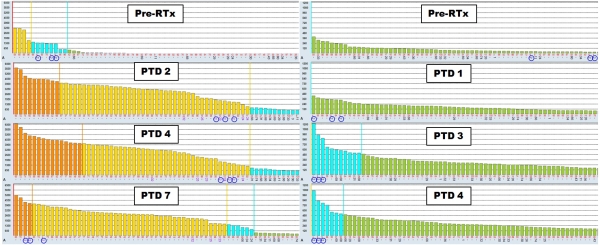Prospective Single Antigen Bead Epitope-Based Clustering for Early Detection of Antibody Mediated Rejection.
U of Cincinnati, Cincinnati.
Meeting: 2016 American Transplant Congress
Abstract number: C6
Keywords: Antibodies, HLA antibodies, Rejection
Session Information
Session Name: Poster Session C: Antibody Mediated Rejection: Session #1
Session Type: Poster Session
Date: Monday, June 13, 2016
Session Time: 6:00pm-7:00pm
 Presentation Time: 6:00pm-7:00pm
Presentation Time: 6:00pm-7:00pm
Location: Halls C&D
Purpose:
Epitope-based groups of HLA single antigen beads (SAB) often demonstrate clustering in patients with donor specific antibodies (DSA). Coordinated Mean Florescent Intensity (MFI) increases of the clustered SABs can indicate an active, emerging DSA response to the renal allograft. Similarly, epitope-based SABs are randomly distributed (in terms of MFI values) when HLA antibodies are absent, and demonstrate epitope-based clustering once a humoral response to the renal allograft is initiated. The purpose of this study was to describe a cohort with SAB epitope-based clustering (EC-SAB) following renal transplantation (RTx).
Methods:
Prospective high frequency DSA monitoring was employed post-RTx in patients (pts) deemed high risk for early DSA response (pts with paternal antigen re-exposure, cPRA > 50%, preformed DSA, slow graft function (SGF) after living RTx). Serum samples were analyzed on post transplant days 3, 7, 10, 14, and 30 by SAB assay. EC-SAB was defined as 1) antibody detection at < 1500 MFI and 2) identification by senior laboratory scientists of a cluster of antigens sharing an epitope on SAB histograms that were randomly distributed (by MFI) on pre-transplant samples. EC-SAB, when detected, prompted allograft biopsy.
Results:
Seven pts were identified with EC-SAB: Caucasian (71%), male (57%), mean age 46+12.3 yrs. Median cPRA was 32% (range 0-95%); all pts had negative flow crossmatches at transplant and 86% developed a positive DSA following EC-SAB identification. Histopathology compatible with AMR was seen in all pts biopsied after EC-SAB identification. All pts received AMR treatment. A 15% drop in SCr was observed in 71.5% of patients after treatment. Fig 1 depicts histograms of 2 pts with A2 EC (pts 1 and 2). Table 1 details whole cohort clinical course.
Conclusions:
EC-SAB, independent of MFI, allowed early AMR detection.
 .
.
 .
.
CITATION INFORMATION: Lichvar A, Tremblay S, Brailey P, Girnita A, Alloway R, Woodle E. Prospective Single Antigen Bead Epitope-Based Clustering for Early Detection of Antibody Mediated Rejection. Am J Transplant. 2016;16 (suppl 3).
To cite this abstract in AMA style:
Lichvar A, Tremblay S, Brailey P, Girnita A, Alloway R, Woodle E. Prospective Single Antigen Bead Epitope-Based Clustering for Early Detection of Antibody Mediated Rejection. [abstract]. Am J Transplant. 2016; 16 (suppl 3). https://atcmeetingabstracts.com/abstract/prospective-single-antigen-bead-epitope-based-clustering-for-early-detection-of-antibody-mediated-rejection/. Accessed December 20, 2025.« Back to 2016 American Transplant Congress
